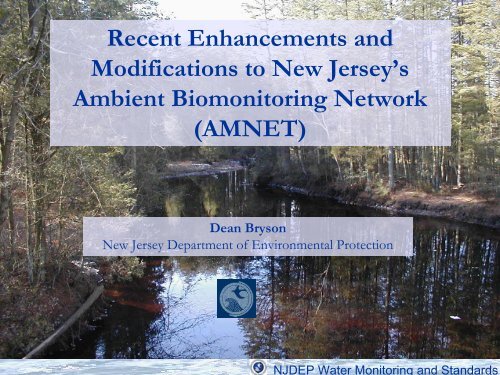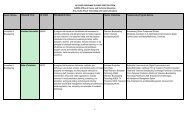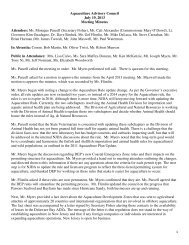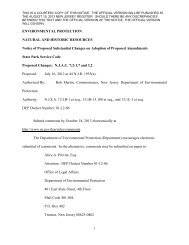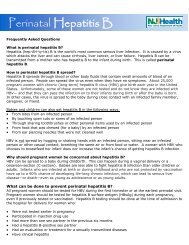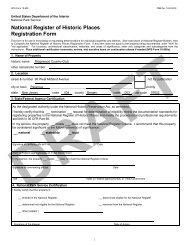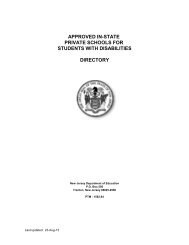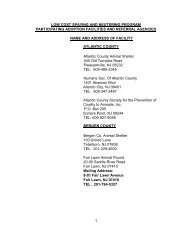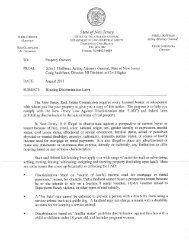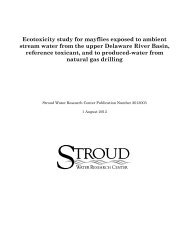High Gradient Macroinvertebrate Index - State of New Jersey
High Gradient Macroinvertebrate Index - State of New Jersey
High Gradient Macroinvertebrate Index - State of New Jersey
Create successful ePaper yourself
Turn your PDF publications into a flip-book with our unique Google optimized e-Paper software.
Recent Enhancements and<br />
Modifications to <strong>New</strong> <strong>Jersey</strong>’s<br />
Ambient Biomonitoring Network<br />
(AMNET)<br />
Dean Bryson<br />
<strong>New</strong> <strong>Jersey</strong> Department <strong>of</strong> Environmental Protection<br />
NJDEP Water Monitoring and Standards
Summary<br />
�� Status <strong>of</strong> AMNET program<br />
�� Development <strong>of</strong> new macroinvertebrate indices<br />
�� <strong>High</strong> <strong>Gradient</strong> <strong>Macroinvertebrate</strong> <strong>Index</strong> (HGMI)<br />
�� Pinelands <strong>Macroinvertebrate</strong> <strong>Index</strong> (PMI)<br />
�� Cases studies with new indices<br />
�� Application <strong>of</strong> Coastal Plain <strong>Macroinvertebrate</strong><br />
<strong>Index</strong> (CPMI)<br />
NJDEP Water Monitoring and Standards
Status <strong>of</strong> AMNET Program<br />
�� Network began in the early-90 early 90’s s and now<br />
consists <strong>of</strong> 822 active sites statewide.<br />
�� Sites are sampled once every 5 years, by Water<br />
Region, on a rotational basis.<br />
�� 3 rd Round <strong>of</strong> all 5 Water Regions completed. 4 th<br />
Round <strong>of</strong> sampling completed in the Upper<br />
Delaware Water Region in June, 2008.<br />
�� Currently, sampling in Northeast Region.
<strong>New</strong> <strong>Jersey</strong>’s <strong>Jersey</strong> s <strong>Macroinvertebrate</strong><br />
Monitoring Network<br />
�� <strong>Index</strong> originally used, called <strong>New</strong> <strong>Jersey</strong> Impairment<br />
Score (NJIS), was based on guidance in original<br />
USEPA’s USEPA Rapid Bioassessment Protocols.<br />
�� NJIS was used statewide throughout the 1990’s 1990 s and<br />
into this decade.<br />
�� Scores from 5 metrics are totaled to give the NJIS. A<br />
rating category, based on the score, is applied- applied non-<br />
impaired, moderately impaired, or severely impaired.<br />
�� <strong>Index</strong> calculated with 100-organism 100 organism subsample with<br />
family-level family level taxonomy<br />
NJDEP Water Monitoring and Standards
Weaknesses <strong>of</strong> NJIS<br />
�� Some nutrient-enriched nutrient enriched streams scored higher than<br />
expected usually because <strong>of</strong> an overabundance <strong>of</strong> a<br />
relatively tolerant caddisfly taxa.<br />
�� The 3 levels <strong>of</strong> impairment lacked resolution in the<br />
moderately impaired category.<br />
�� Data analysis performed on family-level family level data.<br />
�� Moderately enriched streams in Pinelands (higher pH<br />
and SC) tended to score as non-impaired.<br />
non impaired.<br />
�� Some reference sites in Pinelands, with little or no<br />
development and pH readings approaching 4.0, scored<br />
moderately impaired.<br />
NJDEP Water Monitoring and Standards
Seeking Solutions<br />
�� Funding obtained from USEPA-Region USEPA Region 2 for<br />
index development.<br />
�� Contracted Tetra Tech to develop a new index<br />
for high gradient streams (northern NJ) and a<br />
Pinelands-specific Pinelands specific macroinvertebrate index.<br />
NJDEP Water Monitoring and Standards
<strong>Index</strong> Development Steps<br />
�� Collect and organize the data, separating calibration<br />
and verification data;<br />
�� Define reference and degraded sites;<br />
�� Stratify natural biological conditions;<br />
�� Calculate biological metrics and determine sensitivity<br />
<strong>of</strong> each metric;<br />
�� Combine appropriate metrics into index alternatives;<br />
�� Select the most appropriate index based on sensitivity<br />
and variability, and;<br />
�� Assess performance <strong>of</strong> the index.<br />
NJDEP Water Monitoring and Standards
<strong>High</strong> <strong>Gradient</strong> <strong>Macroinvertebrate</strong><br />
�� Reference criteria<br />
�� %Urban & Ag <<br />
20%<br />
�� Habitat score > 75%<br />
<strong>of</strong> total possible<br />
score<br />
�� Not below a dam<br />
�� Reference sites met<br />
all criteria<br />
<strong>Index</strong>
<strong>High</strong> <strong>Gradient</strong> <strong>Macroinvertebrate</strong><br />
Stressed criteria<br />
�� %Urban & Ag ><br />
80%<br />
�� Habitat score <<br />
50% <strong>of</strong> total<br />
possible score<br />
�� Can be below a dam<br />
�� Site defined as<br />
stressed if any one<br />
<strong>of</strong> these is met<br />
�� Stressed criteria<br />
<strong>Index</strong>
Pinelands Reference and Degraded<br />
Site Criteria<br />
Environmental Parameter Reference Criterion Degraded Criterion<br />
Predicted intensive land use (PLU%) < 10% >25%<br />
Percent agricultural land cover < 10% >25%<br />
Percent urban land cover < 10% >50%<br />
Below Dam No No criterion<br />
PLU % = 12 pH + 61log(<br />
spec.<br />
cond.)<br />
−148<br />
Dow and Zampella (2000):<br />
NJDEP Water Monitoring and Standards
NJDEP Water Monitoring and Standards
NJDEP Water Monitoring and Standards
Metric Performance<br />
NJDEP Water Monitoring and Standards
<strong>High</strong> <strong>Gradient</strong> <strong>Macroinvertebrate</strong><br />
�� Family-level Family level<br />
�� # <strong>of</strong> EPT families<br />
�� % <strong>of</strong> families that are non-<br />
insects<br />
�� %EPT (excluding<br />
Hydropsychidae)*<br />
�� # <strong>of</strong> scraper families<br />
�� Family Biotic <strong>Index</strong>*<br />
<strong>Index</strong><br />
*- metric is adjusted based on drainage area<br />
�� Genera-level Genera level<br />
�� Total # <strong>of</strong> genera*<br />
�� % <strong>of</strong> genera that are non-<br />
insects<br />
%EPT 1<br />
1 Excluding all Hydropsychidae except Diplectrona sp.<br />
�� %EPT<br />
�� # <strong>of</strong> scraper genera*<br />
�� Hilsenh<strong>of</strong>f Biotic <strong>Index</strong>*<br />
�� # <strong>of</strong> TALU attribute 2 genera<br />
�� # <strong>of</strong> TALU attribute 3 genera
<strong>High</strong> <strong>Gradient</strong> <strong>Macroinvertebrate</strong><br />
<strong>Index</strong> (gen.)<br />
-Thresholds Thresholds established with 95 percentile <strong>of</strong><br />
reference values and trisection <strong>of</strong> scores below.<br />
- Excellent- Excellent 63&above<br />
Good- Good 42-
Pinelands <strong>Macroinvertebrate</strong> <strong>Index</strong><br />
1. # <strong>of</strong> Insect Taxa<br />
2. # <strong>of</strong> Non-insect Taxa<br />
(PMI)<br />
3. % Plecoptera and Trichoptera<br />
4. % Diptera excluding Tanytarsini<br />
5. % Mollusca and Amphipoda<br />
6. Beck’s Biotic <strong>Index</strong><br />
7. % Filterers<br />
NJDEP Water Monitoring and Standards
PMI Score<br />
80<br />
70<br />
60<br />
50<br />
40<br />
30<br />
20<br />
<strong>Index</strong> Performance<br />
Non-Outlier Max/Min<br />
75% - 25%<br />
Median<br />
Outliers<br />
EXCELLENT<br />
GOOD<br />
FAIR<br />
POOR<br />
Reference Degraded
<strong>Index</strong> Performance<br />
�� Using calibration data set, PMI’s PMI DE was 94.4%<br />
�� With same data set, NJIS had a DE <strong>of</strong> 44.4%<br />
�� May be more sensitive to severe stresses than<br />
moderate stresses. Future refinements may be<br />
necessary to better assess slight to moderately<br />
enriched conditions.<br />
NJDEP Water Monitoring and Standards
Case Studies<br />
�� The following monitoring sites have been<br />
assessed using both the NJIS and the new index.<br />
NJDEP Water Monitoring and Standards
AN0274 Passaic River @ River View Dr.,<br />
Totowa Boro<br />
LU/LC: 37%urban, 46%forest, 2%agriculture, 11%wetlands<br />
Hydropsychidae dominant (35%)
AN0274 Passaic River @ River View Dr.,<br />
Sampled: 6/24/04<br />
NJIS: 27, Non-impaired<br />
HGMI(gen): 29.64, Fair
AN0584 Springers Bk @ Rt. 206<br />
Shamong Twp., Burlington Co.<br />
LU/LC: 26% urban, 33% forest, 23%<br />
agriculture, 17% wetlands<br />
NJDEP Water Monitoring and Standards
AN0584 Springers Bk @ Rt. 206<br />
Sampled: 7/27/05<br />
pH: 6.0<br />
SC: 188<br />
NJIS: 24, Non-impaired<br />
PMI: 45.92, Fair<br />
NJDEP Water Monitoring and Standards
Application <strong>of</strong> PMI<br />
�� To be used for all sites within the boundary <strong>of</strong><br />
the Pinelands Reserve and sites within a 5<br />
kilometer buffer <strong>of</strong> the Reserve.<br />
�� Currently, PMI is being used to assess 195 <strong>of</strong> the<br />
active network sites in Coastal Plain <strong>of</strong> southern<br />
<strong>New</strong> <strong>Jersey</strong>.<br />
�� All other sites, 202 sites, in the NJ Coastal Plain<br />
are assessed using the Coastal Plain<br />
<strong>Macroinvertebrate</strong> <strong>Index</strong>.<br />
NJDEP Water Monitoring and Standards
Coastal Plain <strong>Macroinvertebrate</strong><br />
<strong>Index</strong> (CPMI)<br />
�� Developed in the 90’s 90 s by a multi-state multi state workgroup.<br />
�� Uses genera-level genera level data.<br />
�� Metrics: #Total taxa, #EPT taxa, %Ephemeroptera,<br />
HBI, and %clingers.<br />
�� 4 assessment categories<br />
�� Excellent 22-30 22 30<br />
�� Good 12-20 12 20<br />
�� Fair 6-10 6 10<br />
�� Poor
Questions?<br />
www.state.nj.us/dep/wms/bfbm<br />
NJDEP Water Monitoring and Standards


